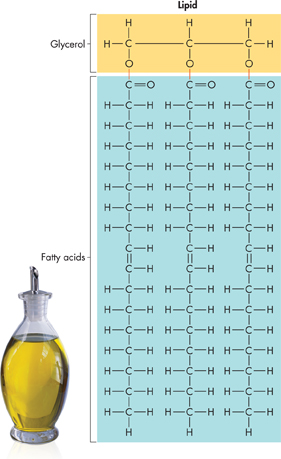▸ Complex Carbohydrates The large macromolecules formed from monosaccharides are known as polysaccharides. Many animals store excess sugar in a polysaccharide called glycogen, which is sometimes called “animal starch.” When the level of glucose in your blood runs low, glycogen is broken down into glucose, which is then released into the blood. The glycogen stored in your muscles supplies the energy for muscle contraction and, thus, for movement.
Plants use a slightly different polysaccharide, called starch, to store excess sugar. Plants also make another important polysaccharide called cellulose. Tough, flexible cellulose fibers give plants much of their strength and rigidity. Cellulose is the major component of both wood and paper, so you are actually looking at cellulose as you read these words!
Lipids Lipids are a large and varied group of biological molecules that are generally not soluble in water. Lipids are made mostly from carbon and hydrogen atoms. The common categories of lipids are fats, oils, and waxes.  Lipids can be used to store energy. Some lipids are important parts of biological membranes and waterproof coverings. Steroids synthesized by the body are lipids as well. Many steroids, such as hormones, serve as chemical messengers.
Lipids can be used to store energy. Some lipids are important parts of biological membranes and waterproof coverings. Steroids synthesized by the body are lipids as well. Many steroids, such as hormones, serve as chemical messengers.
Many lipids are formed when a glycerol molecule combines with compounds called fatty acids, as shown in Figure 2–15. If each carbon atom in a lipid's fatty acid chains is joined to another carbon atom by a single bond, the lipid is said to be saturated. The term saturated is used because the fatty acids contain the maximum possible number of hydrogen atoms.
If there is at least one carbon-carbon double bond in a fatty acid, the fatty acid is said to be unsaturated. Lipids whose fatty acids contain more than one double bond are said to be polyunsaturated. If the terms saturated and polyunsaturated seem familiar, you have probably seen them on food package labels. Lipids that contain unsaturated fatty acids, such as olive oil, tend to be liquid at room temperature. Other cooking oils, such as corn oil, sesame oil, canola oil, and peanut oil, contain polyunsaturated lipids.
 In Your Notebook Compare and contrast saturated and unsaturated fats.
In Your Notebook Compare and contrast saturated and unsaturated fats.

FIGURE 2–15 Lipids Lipid molecules are made up of glycerol and fatty acids. Liquid lipids, such as olive oil, contain mainly unsaturated fatty acids.
Table of Contents
- Formulas and Equations
- Applying Formulas and Equations
- Mean, Median, and Mode
- Estimation
- Using Measurements in Calculations
- Effects of Measurement Errors
- Accuracy
- Precision
- Comparing Accuracy and Precision
- Significant Figures
- Calculating With Significant Figures
- Scientific Notation
- Calculating With Scientific Notation
- Dimensional Analysis
- Applying Dimensional Analysis




